- 1Department of Chemistry, Washington University, St. Louis, MO, United States
- 2Department of Physics, Washington University, St. Louis, MO, United States
The continuum structure of light p-rich elements has been extensively studied in recent years by invariant-mass spectroscopy. The feeble Coulomb barrier for light proton-rich nuclei makes proton decay an essential tool in this region not unlike alpha decay is in the trans-Pb region and neutron-deficient rare earths. Unlike binary alpha decay, the part of the Chart of the Nuclides this mini review will focus on can undergo decay into many-particle final states and invariant-mass spectroscopy is the frame-invariant and multi-particle replacement for simple binary alpha-particle spectroscopy. Here we highlight how pairing is reflected in the zig-zaggy pattern of the drip line, the decay of nuclides beyond the drip lines, and what the masses of nuclides exterior to the p-drip line have taught us about shell structure. In this context, the subtlety of removing the Wigner, or n-p congruence, energy when interpreting nucleon separation-energy systematics is discussed. We also present examples of where isospin symmetry is maintained in the continuum and where it is not.
1 Introduction
For medium and heavy nuclei, the large Coulomb barriers for fission, alpha, and proton decay retard these decays and allow weak decay modes to dominate over large regions of the nuclear chart. As the Coulomb barrier reduces with decreasing atomic number (Z), the proton decay rate increases becoming the dominate decay mode in the South-West part of the chart. Until one reaches decay rates commensurate with nucleon transit times across a nucleus, the nuclei that p-decay are no less real than those with positive Q-values for alpha decay, or for that matter, positive fission Q-values. These metastable nuclei exhibit structure and are amenable to study by a technique that is at its essence no different than what is done with alpha-particle spectroscopy. This technique is called invariant-mass spectroscopy (IMS) and is the tool employed for extracting the results reported here.
This mini-review presents some selected results which have employed IMS operating on knockout, charge exchange, and pickup reaction products. As soon will become clear, the primary utility of using the different reaction types is that the continuum structure of several nuclei in the region of a single secondary beam can be studied in one experiment. Some confirmation of the reaction mechanism can often be found in the velocity of the reconstructed decaying parent nucleus, e.g., a product of a simple knockout reaction will have a velocity close to that of the beam while pickup and charge-exchange products are notably slower [1]. The angular momentum mismatch in intermediate energy pick-up reactions favors population of high-spin states. This feature may, or may not, be advantageous, but cognizance of this bias is certainly required [1, 2].
We will start by showing how pairing is reflected in the zig-zaggy pattern of the drip line and in the total number and type (1p or prompt 2p) proton-decay steps. The second selected topic is a presentation of how the masses of some of the newly discovered light p-rich nuclei have informed us about the evolution of nuclear structure far from stability. In this exercise the subtlety of removing the Wigner, or n-p congruence, energy must be considered as the cases transit through
2 Experimental methods
The invariant-mass technique requires an accurate determination of the energy-momentum 4-vectors of all the products in the final state. From this information, the decay energy
A typical experiment is diagrammed in Figure 1A. The emitted light particles, residue, and any
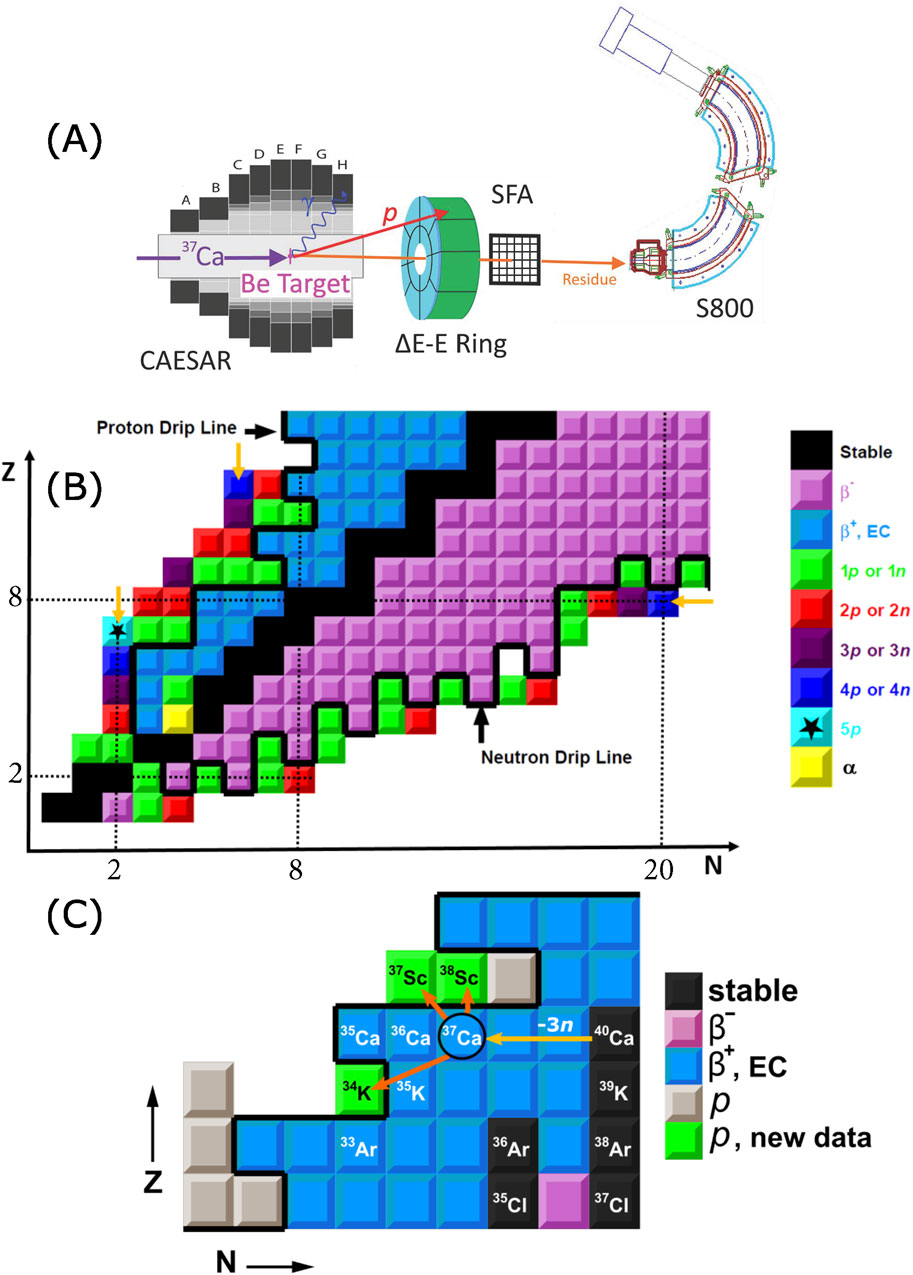
Figure 1. (A) Schematic of an invariant-mass experiment utilizing a position-sensitive
At intermediate energy, stopping of light charged particles requires rather thick scintillators. These scintillators have far inferior energy resolution as compared to double-sided Si detectors that are typically employed for the
Related to the common vertex assumption, and the determination of the relative momentum vectors, an accurate position of the residue, should it exist, is important. All our recent work has employed some version of a 2-dimensional scintillating-fiber array positioned close the plane of the position determining Si detector, to fix the residue trajectory. This position fix of the residue that is ultimately detected in either a spectrometer [7] or in the Si array itself [6] comes at the cost of some modest efficiency loss (
Finally, if the heavy daughter is produced in a bound excited state, the value of the decay energy
3 Selected results
3.1 Decays beyond the drip lines
We start by showing a decays-eye view of the lower portion of the nuclear chart in Figure 1B. The zig-zaggy drip lines are defined in this part of the chart and these lines display easily understood pairing features. Namely, even atomic number (Z) elements have proton drip lines more removed from stability and the neutron-drip line is scalloped with even neutron number (N) isotopes inside and odd N isotopes outside the drip line. As required by the energetics, the number of nucleons emitted is that required to land inside the drip line. The N = 6 isotones, note upper orange arrow, extend from 1 to 4 protons emitted from 15F to 18Mg [14] (with the residue in each being 14O). The N = 2 isotones extend from 5Li up to 9N with the latter (see star) exhibiting the record length decay chain of 5 protons [15]. By examination of the subevents, it is often possible to reconstruct the kinetic decay chain, see, for example, [5]. If Z = odd, the first decay step is always emission of a single proton and long decay sequences are concatenations of 1p and prompt 2p decay steps. The latter principally, but not exclusively, occurs when there is no energy and isospin allowed 1p decay path.
3.2 Wigner-removed separation energies
Using a secondary beam of 37Ca impinging on a 9Be target, resonances corresponding to the ground states of 34K and 37,38Sc were found, see Figure 1C. Using the IMS determined decay energies and the known mass excesses of the daughters, three new masses were determined [9]. These mass measurements allow for an extended look at neutron and proton separation-energy trends, which are shown in the upper panels of Figure 2 (The new masses allowed for calculation of the data represented by stars.) The lower panels in this figure show the separation energy differences defined by
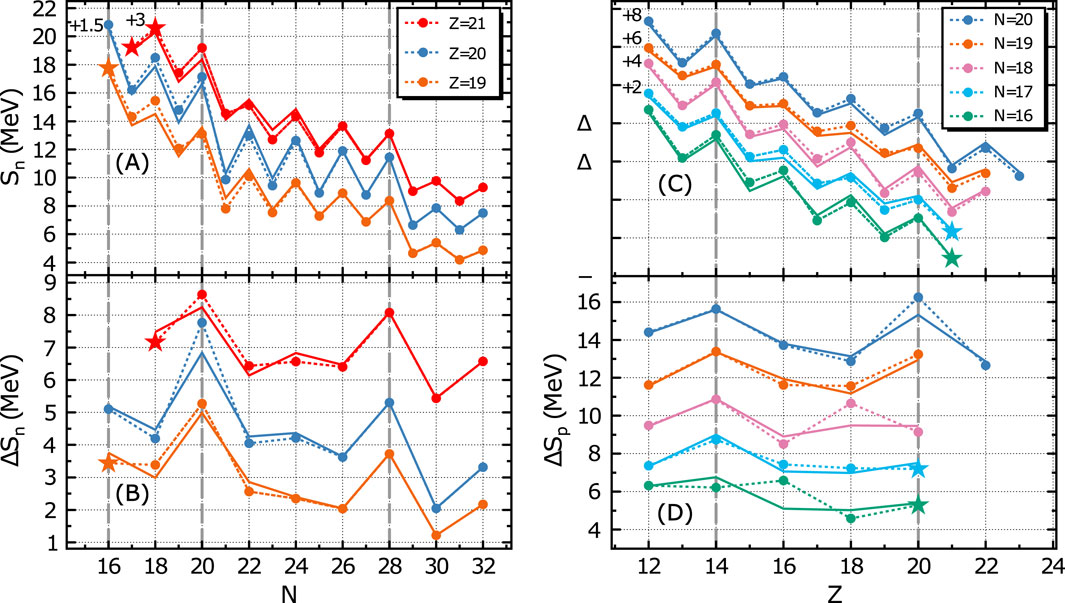
Figure 2. Experimental neutron (A) and proton (C) separation energies and changes in neutron (B) and proton (D) separation energies for even-
First, take note of the expected behavior. The jumps in
Before proceeding to the explore the not-so-obvious trends, for which some inklings were provided above, we have to appreciate that there are three structure issues at play in these mass derived quantities. Two of these are the standard issues of nuclear shells and pairing of like nucleons. The remaining issue, unimportant for heavier nuclei or neutron-rich nuclei, is the so-called Wigner or n-p congruence energy [17, 18]. The latter, included early on in macroscopic mass models, results in extra stabilization near
We are now ready to return to the not-so-obvious trends. The Wigner-energy-removed pseudo-separation energies confirm the suggestion of a
A
Neither the real nor the Wigner-removed pseudo-proton-separation energy differences show an increase at
Finally, we return to an observation made above from Figure 2B - the reduced increase in
3.3 Isospin symmetry
One example of isospin symmetry found in the continuum is mated pairs of 2p emitters. Figure 3 shows two such cases [29, 30]. The schemes on the top show the ground-state 2p decay of Z = even, T = 2 nuclei. These decays are characterized by each proton removing 1/2 of the total available decay energy, a characteristic of decays unperturbed by intermediates and thus indicating “direct” 2p decay. (Experience has taught that if a potential intermediate is broad, it leaves no “finger print” on the decay.) The lower decay schemes show the same T = 2 to T = 1 decays rotated in isospace into the
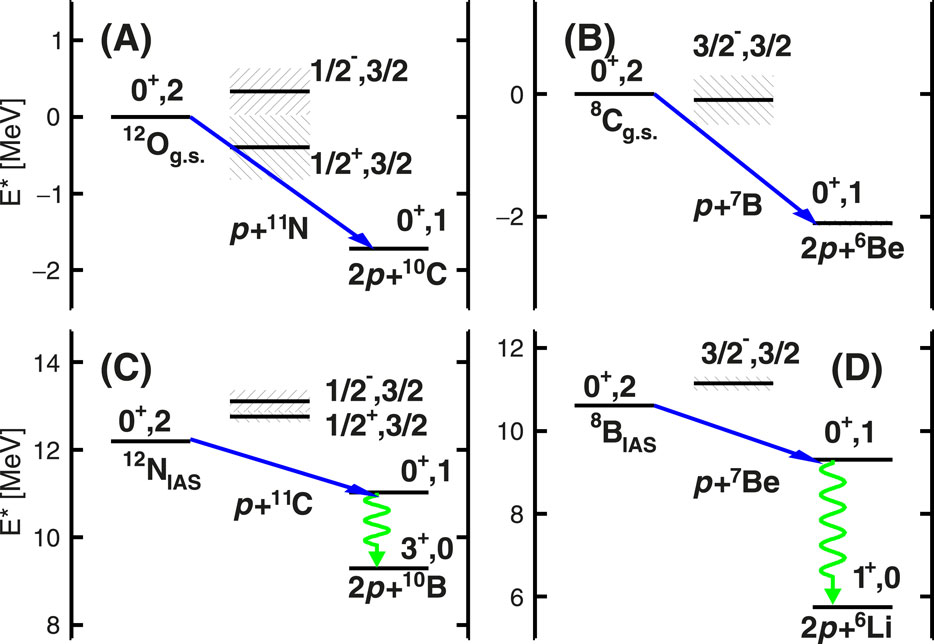
Figure 3. Decay schemes for two mated pairs, A = 12 Left and A = 8 Right, of T = 2 to T = 1 2p decays. (A,B) shows the
Another beautiful example of isospin symmetry in the continuum is the mated rotational bands in the A = 10 nuclei 10Be and 10C. These nuclei become unbound (to n and 2p emission) at 6.812 and 3.821 MeV, respectively. The ground and
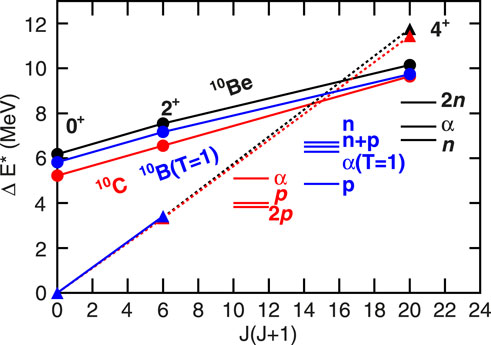
Figure 4. Comparison of analog rotational bands in 10C, 10B, and 10Be. The quantity
3.4 Breaking isospin symmetry
Isospin symmetry can be broken by asymmetric coupling to the continuum. The classic case, considered by both Ehrman [35] and Thomas [36] is for the A = 13 pair 13C and 13N, see Figure 5C, where the ground and first three excited states of the former are bound to neutron decay while for the latter all but the ground state are unbound to proton decay. The excitation energies of the
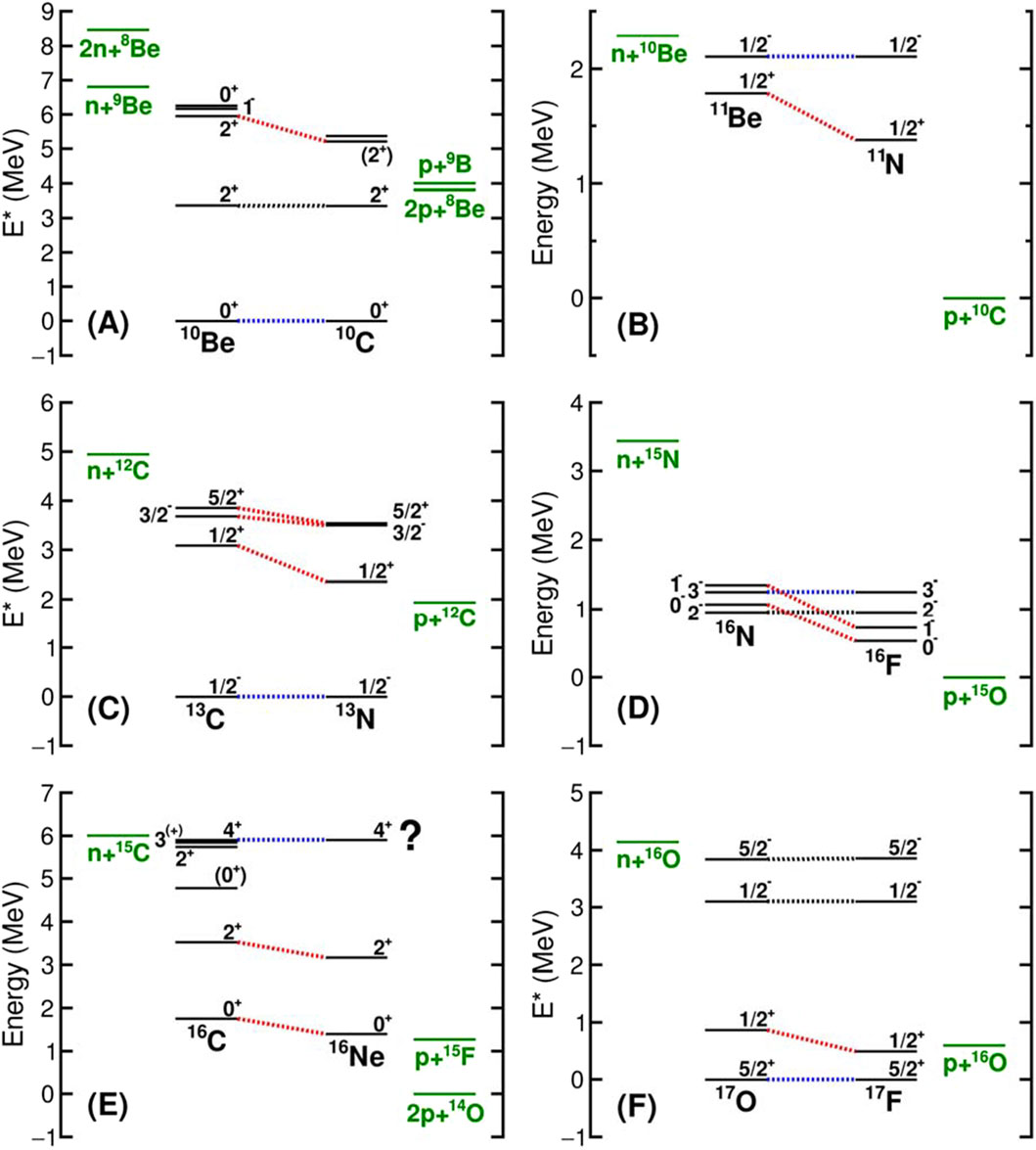
Figure 5. Selection of mirror nuclei which exhibit (or in one case - expected to exhibit) Thomas-Ehrman shifts. In each of the panels analog levels are connected by dotted lines and the relevant decay thresholds are indicated (in green) exterior to the level schemes. The analog levels connected by blue dotted lines are the reference level and those connected by red dotted lines are those with a downward shift for the p-rich nuclide suggesting a substantial s-wave component. When the ground state is the reference state, the ordinate is the actual excitation energy otherwise the ordinate zero is taken as the relevant p-decay threshold. The data for (A–D,F) are taken from ref. 32. The same is true for 16C in (E). However, as the reference (4+) level in 16Ne has not be observed, the positions of the lower levels and thresholds with respect to this level are not fixed.
While several examples of what has been come to be known as “Thomas-Ehrman” (TE) shifts have been known for decades, the study of proton-rich nuclei by IMS has extended the list of known examples several of which are shown in the other panels of Figure 5. The A = 11 and A = 17 cases, 5 (B) and (F) are similar to the A = 13 case (C) in that the
The ground and first excited states for both 10Be and 10C (A) are bound, however there are two levels in 10C well below the third excited state in 10Be but above both the 1p and 2p decay thresholds (The mirror 1n and 2n thresholds for 10Be are above all levels in question.) One of these levels is
The remaining panel of Figure 5E represents a research opportunity. All the levels shown are known [32] except the
4 Conclusion
The lower portion of the Chart of the Nuclides is now mapped out to where nuclei convert from metastable to unstable and thus cease to exist. The pattern of nucleon decays, like the drip-lines themselves, reflect the strong influence of like-nucleon pairing. Sequences of single- and double-proton decay have been mapped out on the p-rich side with the longest chain starting with 9N emitting a single proton to the even Z and well
As with any Fermion system, the punctuation of structure is the irregularity of single-particle levels. However, in the nuclear two-Fermion system, shell structure is conflated with n-p congruence effects. While generally not important, this latter structure effect is important in p-rich light nuclei [26]. Employing a reasonable prescription for removing n-p congruence effects, it was found that a
Two examples of isospin symmetry were presented. One of these, presented in duplicate, is mated pairs of two-proton decay, both T = 2 to T = 1, one from the ground state of the
In our view, the most interesting unresolved questions concerning the structure-reactions (they are intimately spliced) of nuclei near the proton-drip line are related to cases for which multiple open channels exist. Such cases are often found near the drip line but are exceedingly important at high excitation energy near stability, e.g., the 13C (
Author contributions
LS: Funding acquisition, Investigation, Methodology, Project administration, Resources, Supervision, Writing–original draft, Writing–review and editing, Conceptualization, Data curation, Validation. RC: Conceptualization, Formal Analysis, Investigation, Software, Supervision, Visualization, Writing–review and editing, Data curation, Methodology, Validation.
Funding
The author(s) declare that financial support was received for the research, authorship, and/or publication of this article. The work presented in this report is based upon work supported by the U.S. Department of Energy, Office of Science, Office of Nuclear Physics under Awards No. DE-FG02-87ER-40316.
Acknowledgments
The results presented here on the separation energies beyond the proton drip line are part of the thesis work of Nicolas Dronchi who, of course, did the hard analysis work on that project [38].
Conflict of interest
The authors declare that the research was conducted in the absence of any commercial or financial relationships that could be construed as a potential conflict of interest.
Generative AI statement
The author(s) declare that no Generative AI was used in the creation of this manuscript.
Publisher’s note
All claims expressed in this article are solely those of the authors and do not necessarily represent those of their affiliated organizations, or those of the publisher, the editors and the reviewers. Any product that may be evaluated in this article, or claim that may be made by its manufacturer, is not guaranteed or endorsed by the publisher.
References
1. Charity RJ, Brown K, Webb T, Sobotka LG. Invariant-mass spectroscopy of 10B,11C, 14F, 16F, and 18Na. Phys Rev C (2023) 107:054301. doi:10.1103/PhysRevC.107.054301
2. Brink D. Kinematical effects in heavy-ion reactions. Phys Lett B (1972) 40:37–40. doi:10.1016/0370-2693(72)90274-2
3. Charity RJ, Sobotka LG. Invariant-mass spectroscopy in projectile fragmentation reactions. Phys Rev C (2023) 108:044318. doi:10.1103/PhysRevC.108.044318
4. Aad Gthe ATLAS collaboration. A detailed map of Higgs boson interactions by the ATLAS experiment ten years after the discovery. Nature (2022) 607:52–9. doi:10.1016/S0168-9002(98)00960-7
5. Mercurio K, Charity RJ, Shane R, Sobotka LG, Elson JM, Famiano M, et al. Correlated two-proton decay from 10C. Phys Rev C (2008) 78:031602. doi:10.1103/PhysRevC.78.031602
6. Wallace M, Famiano M, van Goethem MJ, Rogers A, Lynch W, Clifford J, et al. The high resolution array (HiRA) for rare isotope beam experiments. Nucl Instrum Methods A (2007) 583:302–12. doi:10.1016/j.nima.2007.08.248
7. Yurkon J, Bazin D, Benenson W, Morrissey D, Sherrill B, Swan D, et al. Focal plane detector for the S800 high-resolution spectrometer. Nucl Instrum Methods A (1999) 422:291–5. doi:10.1016/S0168-9002(98)00960-7
8. Weisshaar D, Gade A, Glasmacher T, Grinyer GF, Bazin D, Adrich P, et al. CAESAR-A high-efficiency CsI(Na) scintillator array for in-beam γ ray spectroscopy with fast rare-isotope beams. Nucl Instrum Methods A (2010) 624:615–23. doi:10.1016/j.nima.2010.09.148
9. Dronchi N, Charity RJ, Sobotka LG, Brown BA, Weisshaar D, Gade A, et al. Evolution of shell gaps in the neutron-poor calcium region from invariant-mass spectroscopy of 37,38Sc, 35Ca, and 34K. Phys Rev C (2024) 110:L031302. doi:10.1103/PhysRevC.110.L031302
10. Charity RJ, Brown KW, Elson J, Reviol W, Sobotka LG, Buhro WW, et al. Invariant-mass spectroscopy of 18Ne, 16O, and 10C excited states formed in neutron-transfer reactions. Phys Rev C (2019) 99:044304. doi:10.1103/PhysRevC.99.044304
11. Binns W, Connell J, Dowkontt P, Epstein J, Israel M, Klarmann J. A scintillating optical fiber track imaging detector. Nucl Instr Methods Phys Res Section A: Acc Spectrometers, Detectors Associated Equipment (1986) 251:402–6. doi:10.1016/0168-9002(86)90808-9
12. Ruchti R. Tracking with scintillating fibers. Nucl Phys B - Proc Supplements (1995) 44:308–19. doi:10.1016/S0920-5632(95)80049-2
13. Back B, Betts R, Gillitzer A, Henning W, Hofman D, Nanal V A beam vertex detector using scintillating fibers. Nucl Instr Methods Phys Res Section A: Acc Spectrometers, Detectors Associated Equipment (1998) 412:191–9. doi:10.1016/S0168-9002(98)00096-5
14. Jin Y, Niu CY, Brown KW, Li ZH, Hua H, Anthony AK, et al. First observation of the four-proton unbound nucleus 18Mg. Phys Rev Lett (2021) 127:262502. doi:10.1103/PhysRevLett.127.262502
15. Charity RJ, Wylie J, Wang SM, Webb TB, Brown KW, Cerizza G, et al. Strong evidence for 9N and the limits of existence of atomic nuclei. Phys Rev Lett (2023) 131:172501. doi:10.1103/PhysRevLett.131.172501
16. Lalanne L, Sorlin O, Poves A, Assié M, Hammache F, Koyama S, et al. N=16 magicity revealed at the proton drip line through the study of 35Ca. Phys Rev Lett (2023) 131:092501. doi:10.1103/PhysRevLett.131.092501
17. Garvey GT, Gerace WJ, Jaffe RL, Talmi I, Kelson I. Set of nuclear-mass relations and a resultant mass table. Rev Mod Phys (1969) 41:S1–S80. doi:10.1103/RevModPhys.41.S1
19. Satuła W, Dean D, Gary J, Mizutori S, Nazarewicz W. On the origin of the Wigner energy. Phys Lett B (1997) 407:103–9. doi:10.1016/S0370-2693(97)00711-9
20. Goriely S, Chamel N, Pearson JM. Further explorations of skyrme-Hartree-Fock-Bogoliubov mass formulas. xiii. the 2012 atomic mass evaluation and the symmetry coefficient. Phys Rev C (2013) 88:024308. doi:10.1103/PhysRevC.88.024308
21. Otsuka T, Fujimoto R, Utsuno Y, Brown BA, Honma M, Mizusaki T. Magic numbers in exotic nuclei and spin-isospin properties of the NN interaction. Phys Rev Lett (2001) 87:082502. doi:10.1103/PhysRevLett.87.082502
22. Mutschler A, Lemasson A, Sorlin O, Bazin D, Borcea C, Borcea R A proton density bubble in the doubly magic 34Si nucleus. Nat Phys (2017) 13:152–6. doi:10.1038/nphys3916
24. Beck T, Gade A, Brown BA, Tostevin JA, Weisshaar D, Bazin D, et al. Probing proton cross-shell excitations through the two-neutron removal from 38Ca. Phys Rev C (2023) 108:L061301. doi:10.1103/PhysRevC.108.L061301
25. Dronchi N, Weisshaar D, Brown BA, Gade A, Charity RJ, Sobotka LG, et al. Measurement of the B(E2↑) strengths of 36Ca and 38Ca. Phys Rev C (2023) 107:034306. doi:10.1103/PhysRevC.107.034306
26. Buskirk L, Godbey K, Nazarewicz W, Satuła W. Nucleonic shells and nuclear masses. Phys Rev C (2024) 109:044311. doi:10.1103/PhysRevC.109.044311
27. Kramer G, Blok H, Van Den Brand J, Bulten H, Ent R, Jans E, et al. Proton ground-state correlations in 40Ca studied with the reaction 40Ca(e,e’p)39K. Phys Lett B (1989) 227:199–203. doi:10.1016/S0370-2693(89)80022-X
28. Chen J. Nuclear data sheets for A = 39. Nucl Data Sheets (2018) 149:1–251. doi:10.1016/j.nds.2018.03.001
29. Charity RJ, Elson JM, Manfredi J, Shane R, Sobotka LG, Chajecki Z, et al. 2p-2p decay of 8C and isospin-allowed 2p decay of the isobaric-analog state in 8B. Phys Rev C (2010) 82:041304. doi:10.1103/PhysRevC.82.041304
30. Jager MF, Charity RJ, Elson JM, Manfredi J, Mahzoon MH, Sobotka LG, et al. Two-proton decay of 12O and its isobaric analog state in 12N. Phys Rev C (2012) 86:011304. doi:10.1103/PhysRevC.86.011304
31. Brown KW, Buhro WW, Charity RJ, Elson JM, Reviol W, Sobotka LG, et al. Two-proton decay from the isobaric analog state in 8B. Phys Rev C (2014) 90:027304. doi:10.1103/PhysRevC.90.027304
32. NNDC. Evaluated nuclear structure data file (ENSDF) (2024). Available from: https://www.nndc.bnl.gov/ensdf/ (Accessed September, 2024).
33. Curtis N, Achouri NL, Ashwood NI, Bohlen HG, Catford WN, Clarke NM, et al. Breakup reaction study of the brunnian nucleus 10C. Phys Rev C (2008) 77:021301. doi:10.1103/PhysRevC.77.021301
34. Charity RJ, Sobotka LG, Webb TB, Brown KW. Two-proton decay from α-cluster states in 10C and 11N. Phys Rev C (2022) 105:014314. doi:10.1103/PhysRevC.105.014314
35. Ehrman JB. On the displacement of corresponding energy levels of 13C and 13N. Phys Rev (1951) 81:412–6. doi:10.1103/PhysRev.81.412
36. Thomas RG. An analysis of the energy levels of the mirror nuclei, 13C and 13N. Phys Rev (1952) 88:1109–25. doi:10.1103/PhysRev.88.1109
37. Charity RJ, Wiser TD, Mercurio K, Shane R, Sobotka LG, Wuosmaa AH, et al. Continuum spectroscopy with a 10C beam: cluster structure and three-body decay. Phys Rev C (2009) 80:024306. doi:10.1103/PhysRevC.80.024306
38. Dronchi ND. Proton-decay branches and structures in 7Li and neutron-poor nuclides around calcium. Phd thesis. Saint Louis, MO: Washington University (2024). Available from: https://openscholarship.wustl.edu/art_sci_etds/3277/.
Keywords: invariant mass, Wigner energy, intermediate energy, shell structure, reactions
Citation: Sobotka LG and Charity RJ (2025) Using intermediate energy knockout, pickup, and charge exchange reactions with invariant mass spectroscopy for investigating nuclear structure beyond the proton drip line. Front. Phys. 12:1511402. doi: 10.3389/fphy.2024.1511402
Received: 14 October 2024; Accepted: 29 November 2024;
Published: 03 January 2025.
Edited by:
Alan Wuosmaa, University of Connecticut, United StatesReviewed by:
Linda Hlophe, Michigan State University, United StatesAndres Arazi, National Atomic Energy Commission, Argentina
Copyright © 2025 Sobotka and Charity. This is an open-access article distributed under the terms of the Creative Commons Attribution License (CC BY). The use, distribution or reproduction in other forums is permitted, provided the original author(s) and the copyright owner(s) are credited and that the original publication in this journal is cited, in accordance with accepted academic practice. No use, distribution or reproduction is permitted which does not comply with these terms.
*Correspondence: L. G. Sobotka, bGdzQHd1c3RsLmVkdQ==
 L. G. Sobotka
L. G. Sobotka R. J. Charity
R. J. Charity